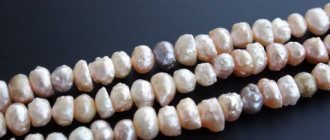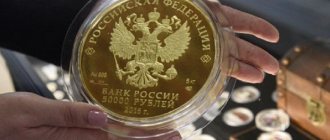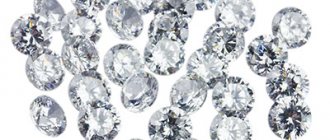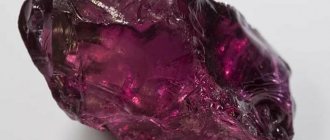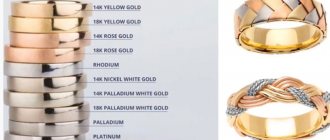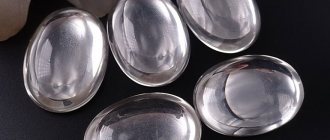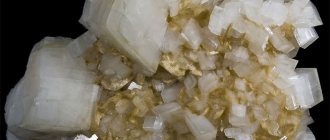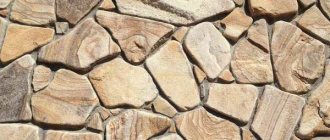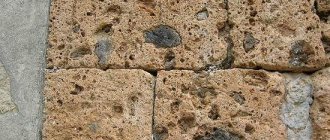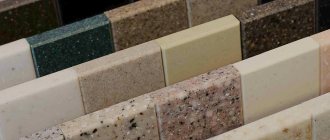Surely many have seen jewelry with inserts of large, smooth, rounded stones - in the boxes of grandmothers and mothers, at fairs where they buy souvenirs. Not everyone is aware that this type of cut (or rather, its absence) is called “cabochon”. How and from what cabochons are made, and why smooth stones from the Middle Ages are experiencing (another!) rebirth in modern designer jewelry - read in our new article.
Necklace with rock crystal and rose quartz cabochons, photo from khramtsovajewelry.com
A little history
"Cabochon" is a transliteration of the French word "cabochon". It is translated as “nail with a hat,” although some philologists insist on the “head” version.
When processed as a cabochon, the stone, due to grinding, acquires a convex round shape on one side and becomes flat on the other. This look, according to French jewelers, resembles the head of a nail.
When asked about how the cabochon cut became popular, the Russian Internet unanimously gives out the legend of the “French cardinal Jules Mazarin,” the same one about whom (in the Italian version - Mazarin) Dumas wrote in “The Musketeers”, and who is believed to , and popularized cabochons in the 17th century. Mazarin, who became the first minister of France, truly had a magnificent collection of diamonds, and with it, a complex character. Perhaps this is why popular rumor persistently attributes to Mazarin the desire to “save carats” - the cardinal allegedly asked his craftsmen to polish the diamond instead of cutting it. We don’t know whether this is true or not, but the magnificent Gran Mazarin diamond at the Christie’s auction in 2017 looked quite cut.
In fact, long before the cardinal, “smooth stones” firmly occupied the jewelry Olympus. The English version of Wikipedia succinctly states that “the cabochon was considered the default method of stone processing before cutting was invented.” It is these smooth stones that can be found on the outfits of royal nobility from the Middle Ages.
Today there are enough cutting industries in the world, and cabochons are no longer a necessary measure. But instead of disappearing from the rings and pendants of their owners, cabochons, on the contrary, are only gaining popularity all over the world. And gradually - with us, despite the nuances, which will be discussed below.
Prong setting
Securing a stone in a frame using prongs - metal tides (stands) protruding above the upper edge of the frame - is called prong setting. It is used to secure almost all types of inserts made of gems and colored stones.
Prong setting provides better illumination of the cabochon than solid setting, allows you to see its shape, cut, perform a routine inspection, and wash the stone. Jewelry with prong setting cabochons gives a pleasant impression of openwork and lightness.
Prong setting is the most common type.
How is a cabochon born?
Most often, cabochons are made from rocks, minerals and semi-precious stones. Opaque gems with defects, intricate veins and optical effects look most impressive in this surface treatment.
The master selects the stone, marks the boundaries of the future cabochon and cuts it taking into account the material that will be cut off during polishing.
The most important thing is ahead - the cut piece of rock is given the famous convex shape. To ensure that the surface is perfectly smooth, special equipment is used - a grinding and polishing machine. Thanks to them and various powders and pastes, the cabochon reaches its ideal state.
But some cabochons do not fall into perfectionists' heaven - craftsmen give the stones the desired shape with virtually no grinding. This technique fits perfectly into the jewelry concept of being close to nature.
Rings with cabochons of different stones, photo from Instagram @granat_silver
Application options for craftsmen
Most often, cabochons are used in products made from natural gems. Rings, beads, earrings, etc. are made from the resulting stones. They decorate boxes, precious frames of icons and books, etc. In jewelry, stones are framed with a thick metal frame and braided with pearls or rhinestones. Gold goes better with transparent minerals; in other cases, silver or metal alloys can be used.
Acrylic or glass beads are sometimes trimmed using the cabochon method. They are painted, drawings and patterns are applied to them. Rounded glass elements on black velvet, decorated with small pearls or matte beads, look good.
Cabochons are also used in needlework: they are used to decorate bags, collars and cuffs. Small round stones are strung on a fishing line and made into earrings, bracelets, etc. To secure, use glue or special holders, which are sold in handicraft stores.
The choice of stone depends on the age of the owner: large oval or spherical cabochons are more suitable for older ladies, while young people are better off using gems in the shape of a heart, drop, etc. For men, products with square or rectangular stones are suitable.
Using smooth glass stones, compositions are created: inscriptions are made on a flat base and covered with a transparent cabochon, which enlarges them.
Glass inserts are used in the manufacture of stained glass.
Forms and effect
The most common cabochons are those that look like a hill: flat at the bottom and convex at the top - they are called simple. But there are others: bilaterally convex and convex-concave. Perhaps now you remember with a shudder your school physics lessons, where various forms of lenses were taught. In fact, cabochons use the same technologies as lenses to enhance color and create optical effects.
Does the internal glow of the stone leave much to be desired? A double-sided convex cabochon will come to the rescue. Is the dark cabochon color not bright enough? A convex-concave shape will solve the problem.
The production of cabochons is strictly standardized, so you shouldn’t expect any weird shapes. Most often, cabochons made from natural stones look like circles, ovals, polygons, or like a heart if the buyer is a particularly romantic person.
The choice of shape depends not so much on the taste preferences of the customer and the craftsman, but on the properties of the stone itself. For example, if the stone is soft, then experienced craftsmen will make a round or oval cabochon out of it, and if it is hard, this is a whole field for experimentation.
Production stages
Today, the process of producing cabochons from natural minerals is automated; all operations are performed using devices and equipment.
The technology for processing cabochon stones is divided into the following stages:
- The crystal is subjected to rough processing - it is given the desired shape.
- The resulting workpiece is treated with a special cleaner.
- Contours are drawn onto the stone, along which finishing is carried out. Irregularities are ground off with a disk or saw, and sharp corners are smoothed out with a grinding wheel.
- After giving the desired shape, the cabochon is polished. In mass production, tumbling drums with metal balls are used for this purpose. Handmade cabochons are polished with felt or felt wheels.
Cabochons are made not only from natural stones, but also from ordinary glass. In this case, molten glass is poured into prepared molds. After cooling, the resulting crystals do not require additional processing.
Cabochons in Russia: old versus new
The reputation of cabochons in the minds of domestic craftsmen and buyers is very ambiguous - this has happened historically, and there are at least two reasons for this.
Firstly, to create a cabochon they often take “ornamental” stones - malachite, charoite, lapis lazuli and the like. For a strange reason, in Russian textbooks on jewelry making, the “precious/semi-precious/ornamental” gradation is still alive, where precious stones are given all sorts of honors (including them in the law with restrictions on circulation), and “semi-precious stones,” including rare and unique ones, as well as other, sometimes very expensive, ornamental items, they receive orders of magnitude less respect. And secondly, stones with defects are often used in cabochons - albeit beautiful, but undesirable from a professional point of view, patterns of veins, color spots and irregularities.
It is precisely for these reasons that until recently souvenir fairs were inundated with conventional rings with large gems. Cheap, and grandma will be happy. Decent earrings should be “cut.” But time is changing, and with it the attitude towards natural gifts.
Fashion houses like Cartier and Dior include cabochons in their jewelry lines, and Martin Katz, the jewelry designer who supplies Nicole Kidman and Angelina Jolie with red-carpet pieces, produces collections featuring a huge variety of uncut stones.
Accordingly, in the West, cabochons have a more than privileged status. This can be explained by nothing other than the properties of the “anti-cut” itself. Despite the fact that stones with defects are used for them, ultimately they acquire such a depth of color and inner glow that facet cutting has never dreamed of (read our guide to the types of stone cuts). In addition, the resulting cabochon looks more impressive due to its size (it is estimated that when cutting a gemstone loses up to 30% of its weight).
Ring with a cabochon made of malachite stone, photo from khramtsovajewelry.com
Peculiarities
Cabochon is a treatment that allows you to reveal the depth of color of the gemstone. It makes it possible to carefully examine the pattern inside the mineral, to see traces of its formation and inclusion of other elements. In this case, the optical effects will be less noticeable than with faceted cutting.
The cabochon is formed as follows. The bottom of the stone is ground to make it flat. The upper one is turned into a semicircle with the most regular shape. If necessary, the stone is subjected to further processing - to lighten, increase contrast, and color saturation. There are also “double cabochons”, consisting of two semicircles: they create an unusual glow effect.
The method is used for processing opaque and translucent stones with a dull shine. Transparent minerals are rarely processed into cabochons: for them, the play of light that appears during faceted cutting is more valuable.
Russian buyers learn the word “cabochon”
“Trends from the West” are inexorably approaching the borders of the homeland. Despite the fact that a significant part of the Russian market is still occupied by minimalistic wire rings and earrings with baroque pearls and crumpled metal, they are gradually retreating under the onslaught of statement jewelry. And a large polished stone with a rich “inner world” is the most understandable “accent”.
The post-quarantine demand from jewelry lovers for closeness to nature and a domestic brand deserves special attention. Considering that Russia is a country known for its minerals and rocks, this request can be fully satisfied.
Among the works of modern Russian designers, you can already find excellent items made of silver, in which delicate quartz, garnets and labradorites glow mattely. Residents of megacities are increasingly willing to purchase “tactile stones” in rings and necklaces, and chats of specialists are increasingly filled with the call: “guys who sell cabochons, write in direct!”
Author:
Daria Blokh
The most interesting things on the portal | Jewelerum's Guide to Natural Stones | How to wear it? - Jeweler's guide to jewelry trends | All publications by tag Natural-ethnic-primitivism style
Corner setting
The process when the insert is secured with the help of corners raised with a sharpie from the metal of the product, and the cabochon itself is placed in a socket - a support belt in the hole of the product - is called corner setting. Most often it is used to secure transparent stones so that they can be illuminated both from above and from below. This type of setting is especially indispensable in multi-stone products, when the combination of the color of numerous stones, corners and a through pattern specially cut on the side of the frame gives the product a special elegance, effectiveness, and attractiveness.
